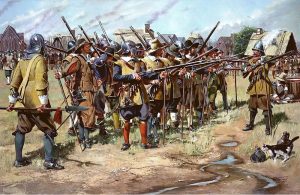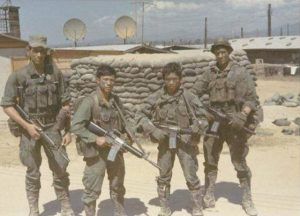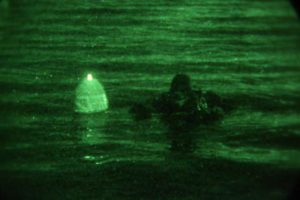Some things, people don’t really think too much about. Even when people see pictures of it, they don’t really think about, much, unless it is specifically referenced. This week, we’re going to look at one of those things.
Soldiers carry stuff; sometimes, a lot of stuff. That is fairly well understood by most people, but for most, the idea of carrying this around centers on a backpack, purse or some other type of satchel. Armies around the world have had to deal with this problem for millennia. For the most part, armies before roughly the 1890’s had variations of a single solution: the baldric.
A baldric is simply a wide and heavy leather strap that goes over one shoulder, and holds something over the opposite hip, much like a lady’s purse, or a modern “messenger bag”. From the 17th to the 19th centuries, most European armies used a pair of baldrics to carry a cartridge box on one side, and a bayonet on the other; occasionally, some type of “haversack” was slung next to the bayonet. Anything heavier typically went into either a rather primitive (by modern standards) backpack, or onto wagons or pack animals. As long as soldiers used simple muzzleloading muskets, this was sufficient for most campaigns.

However, as small arms technology dramatically advanced in the late 19th century, new methods of carrying weapons were needed.
The problem was not simply new “bits-n-bobs”, but increasing weight. Weight is the bane of any soldier’s existence. Carrying heavy loads – frequently exceeding 120lbs/54kg – beats down any person quickly, and in a time where motorized transport was not an option, this could halt an army faster than any destroyed bridge.

The solution, at first, was to connect a belt to suspenders. This distributed the weight between the waist and shoulders, and proved to be a great help in load carrying. This lasted into the 21st century, best known as “ALICE Gear” (All-purpose Lightweight Individual Carrying Equipment).

The ALICE system, and its foreign copies, was an excellent and highly customizable way to carry equipment, opening up the ability to carry more tools into combat (because there is no rest of the weary). But then, something new began to appear in combat zones.

In the mid-1950’s, Communist China decided that it needed a load-carrying system for its troops, adapted to their adoption of the Russian SKS rifle. Since the SKS uses fixed, 10-round strip-clips, the Chinese created a bandolier that could hold some 200 rounds, along with a small bottle of cleaning oil.

While this was fine for the SKS, the Chinese quickly adopted their homegrown variant of the Russian AK-47 right after adopting the SKS. Since AK-type weapons all use a very prominent curved magazine, this required a completely new type of carrying equipment.
The result was the Type 56 Carrier (the first “Chest Rig”).

Like the SKS bandoleer before it, the Type 56 Carrier fit over the front part of the body, but was completely off the waist, using its shoulder straps to carry all the weight. Will not at all modular (as that was not really a concern for any military forces at the time), it was a simple, easy to produce design that got the job done.
The Type 56 Carrier design swiftly began to spread around the world. It’s simplicity and ease of manufacture allowed it to be copied in small “guerrilla” manufacturing shops, giving small armies, as well as insurgent/guerrilla forces a huge advantage, bring them into the same equipment capability range as regular armies. In the United States, at least, new chest rigs developed from the Type 56 can be bought for as little as $36. As well, the chest rig design is highly adaptable, allowing for the carrying of hand grenades, radios and all sorts of other gear.

But there are added benefits to the design that other load-carrying systems cannot match: vehicles.
More conventional, ALICE-type harnesses can be problematic when the wearer tries to enter a vehicle, as the various pouches on the harnesses belt do not fit well with most vehicle seats. In fact, fully loaded pouches can be downright painful when sitting in most car seats.
In contrast, the chest rig allows the wearer a much more comfortable rid. An additional distinct benefit for the chest rig in a vehicle is the ability to reload a weapon easily; more conventional rigs to not lend themselves to this ability.
Chest rigs are certainly not without the issues: “hitting the deck” (i.e., getting as flat onto the ground as possible) is much harder in a chest rig than in a more conventional harness. At the troop level, however, troops find ways to compensate – training is, after all, more important than the tools themselves: you learn to train with what you have, not with what you might want.
So.
Why an article on something most people don’t give much thought to? Simply put, weapons are very, very good things to have. But, to make the best use of those weapons, a person needs to learn to use other tools to utilize those weapons to their fullest potential – when you look at pictures of troops, don’t “just” look at their weapons, look at what they are wearing, to carry all the other gear that they need.
It is said that you “fight as your train”. That is driven not just by the weapons you carry but by the gear you need to make those weapons work to their potential.
You never know when that might become necessary knowledge.
Forewarned is forearmed.















